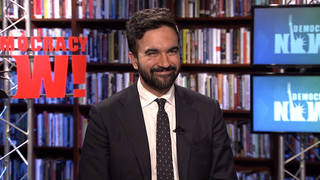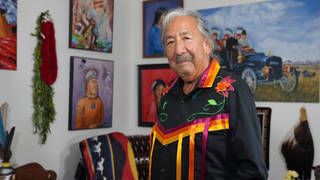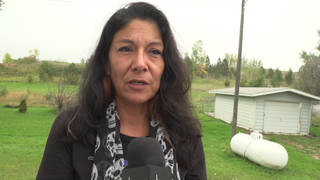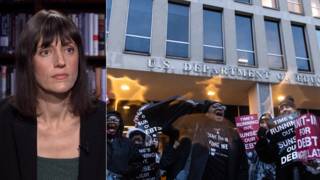
Topics
Guests
- James Steeleveteran investigative reporter and Pulitzer-Prize-winning journalist. His recent article for Reveal from the Center for Investigative Reporting is titled “Who Got Rich Off the Student Debt Crisis.”
- Saul Newtonfounder and executive director of the Wisconsin Veterans Chamber of Commerce. He dropped out of the University of Wisconsin-Stevens Point because of rising costs and student debt, and joined the Army in order to qualify for the GI Bill.
We continue our conversation looking at student debt. A stunning 42 million people now owe $1.3 trillion in student debt. A new investigative report published by Center for Investigative Reporting peels back the layers on this trillion-dollar industry. The article, titled “Who Got Rich Off the Student Debt Crisis,” follows what happened after the federal government relinquished direct control of the student loan program and opened it up to banks and profit-making corporations. We speak to Pulitzer-Prize-winning journalist James Steele and Saul Newton, who was profiled in the article. Saul dropped out of the University of Wisconsin-Stevens Point because of rising costs and student debt.
Transcript
JUAN GONZÁLEZ: We end today’s show looking at a common but crippling affliction: student debt. A stunning 42 million people now owe $1.3 trillion in student debt. A new investigative report published by the Center for Investigative Reporting peels back the layers on this trillion-dollar industry. The article, titled “Who Got Rich Off the Student Debt Crisis,” follows what happened after the federal government relinquished direct control of the student loan program and opened it up to banks and profit-making corporations.
AMY GOODMAN: One of the article’s authors, veteran investigative reporter, Pulitzer-Prize-winning journalist Jim Steele, joins us now.
Welcome back to Democracy Now! Lay out what you found.
JAMES STEELE: What we found was that, if you go back to Lyndon Johnson, the whole idea of the student loan program was to provide a way for people—poor, minorities, so forth—to give them a way to go to college, and it was to provide the loans. And it was administered largely by the federal government, though banks were involved. But by the late 1990s, through the privatization of Sallie Mae and the signal that sent, they turned over this extremely important function, largely, to private industry—Sallie Mae, banks, other financial institutions, private equity companies—not just the issuing of loans, but also the servicing of the loans and, maybe more importantly, those that collected delinquent loans. I mean, the complaints you hear over and over again from students, former students, is the harassment, the kind of pressure they’re put under—the whole idea that is to collect money, not to figure out a way for them to pay loans that they’ve taken out.
JUAN GONZÁLEZ: And by the late 1990s, you’re talking—this is when Bill Clinton was president, and the Gingrich Congress?
JAMES STEELE: The Gingrich Congress. Bill Clinton had, actually, a pretty good idea to turn the program largely over to the federal government to issue the loans—something that later happened in the Obama administration. But when the Gingrich revolution came in in '94, they reversed that. And they technically saved Clinton's program, but they did it in such a way, with the privatization of Sallie Mae and the message they sent, about “this is where we want to go, we don’t want government involved any more than it has to be in our loans”—the whole message was clear as a bell: Private industry should take this over; the federal government, government, should not. And that was the impetus back in the late 1990s.
AMY GOODMAN: Can you explain more who Albert Lord was?
JAMES STEELE: Albert Lord was a fellow who was a lifelong fellow at Sallie Mae. Sallie Mae originally was a public-private partnership—the federal government, the banks. But it was overseen, fairly significantly, by the federal government for many, many years. But after the privatization of Sallie Mae, Lord became CEO, and he took it to a totally different level. They bought servicing companies, they bought companies that collected the delinquent loans, they began issuing private loans, they began issuing federal loans—things that they could not do beforehand. It became a colossus of the student loan industry. In the minds of a lot of students, they thought it was still part of the federal government. But it wasn’t. It was a private company, making hundreds and hundreds of—actually, billions of dollars in profits over the years. Lord himself did very well, hundreds of millions of dollars. He made so much money—and this is the thing that astonished us when we looked at this—he made so much money, he was able to build his own private golf course. Now, I’m not talking about a private club, where any of us could like put in an application, maybe be turned down. I’m talking about your own private golf course in southern Maryland, near Annapolis—I mean, that’s the kind of money he made—so he and his buddies could play golf there, at will.
JUAN GONZÁLEZ: And, of course, the rise of private loan—the loan industry coincided with the rise of more for-profit colleges, as well, right? So there were all of these institutions that were basically being fueled by loans.
JAMES STEELE: Absolutely. And the whole message with the privatization of Sallie Mae was: We want the private industry involved in this process. So, sure enough, private equity companies, hedge funds, others began buying the for-profit colleges. And I think we all know how that worked out. So much of the really bad debt is from that sector of the industry.
AMY GOODMAN: Jim Steele, I want to bring in someone you wrote about: Saul Newton, founder and executive director of the Wisconsin Veterans Chamber of Commerce. He dropped out of the University of Wisconsin-Stevens Point because of rising costs and student loan, and joined the Army in order to qualify for the GI Bill.
Saul Newton, welcome to Democracy Now! You were making online payments for your student loans from Afghanistan?
SAUL NEWTON: That’s correct. First, thank you very much for having me. I appreciate the opportunity to be on. Yes, while I was—while I was deployed to Afghanistan in 2010 and 2011, I also had to make sure that I was making my monthly student loan payments to protect my financial future.
AMY GOODMAN: Can you talk about how much student debt you amassed?
SAUL NEWTON: Yeah. So, I started in—I started college in 2007. And I had always wanted to go to college, but I knew that financially it would be a hardship. So I chose to go to a smaller state university, public university, because I knew that the financial obligation would be less. But over the course of two years, my yearly tuition bill rose $1,600. And so, while I was going to school, I was also working multiple jobs, trying to make ends meet. But I was drowning. And so, in 2009, I decided to drop out of college, join the Army, so that I could qualify for the GI Bill. And by that point, I had just over $10,000 in student loan debt. And so, I did that. I enlisted in the Army. About six months after I enlisted, I was deployed to Kandahar in Afghanistan. And before I deployed, I called my student loan servicer, and I said, you know, “I’m serving on active duty in the military. I’m about to deploy. Is there anything that’s available for me?” And they told me, “No.” So I just accepted that and made sure that every month, after I went out on a patrol or after I got done with work for that day, I made my way over to a small wooden shack with a satellite connection to get onto the internet and pay my student loan bill.
JUAN GONZÁLEZ: And, Jim Steele, the whole—can you talk about what the average debt is that American students are coming out of college with? And also, this whole issue that the loan companies will let you not pay off the principal, because you’re constantly accumulating more interest that you owe, so if you wait four or five years, the debt just grows.
JAMES STEELE: That’s the heart of this, in many ways. I think the average debt right now is probably around $35,000. All the data on this is not always the best data, and it seems like the data is behind where people really are. So it’s roughly around $30,000, probably a little higher. That’s undergraduate; graduate is much, much higher than that. But here’s what goes on. If you put your loan in forbearance, meaning, for some reason or another—you’ve lost your job, you’re sick—you can’t make a payment, it’s in forbearance. But the interest begins to accumulate. So we talked to many, many students, who had actually once had, let’s say, $50,000 of debt by the time they left college, now owe $90,000 and $100,000, but during that period may have paid $50,000 or $60,000, because of the interest and the penalties, things of that sort. So the interest is such a crucial factor. This is why it’s $1.3 trillion overall. It’s past credit card debt. It’s the great go-go growth industry of the whole debt collection field.
AMY GOODMAN: What needs to be done to reform the industry?
JAMES STEELE: Well, one of the things—a principal thing has to be, certainly, more oversight by the Department of Education. They’ve fallen down on this job. There’s actually a pilot program in Treasury Department right now to take this back, bring some of this back to government, where the incentive of the people who are collecting the bills is not to earn a profit, which is the way it is now. Privatization profit making works great in many fields, but it’s not working well in this field to the interests of these students. So that’s one of the principal things. The Department of Education has just consistently fallen down in overseeing its duties there. Servicemen are a perfect example of this—all kinds of complaints about improper representation of what they’ve had. And the Department of Education did an internal study and said, “Oh, yes, we’re doing a pretty good job on it.” Their own inspector general, a few months, came back and said, “You’ve done a horrible job on this. You’re not performing your proper mission here.” So, that’s, I think, a key thing. Probably getting the companies out of that field, turning a lot of this back over to the government, I know that’s an anathema in America, but that’s probably part of the solution.
AMY GOODMAN: Saul Newton, have you paid off your debts?
SAUL NEWTON: I’m very close to paying off the student loans that I accumulated before I joined the Army. I’ve got about $1,000 left in principal to pay off.
AMY GOODMAN: Well, we’re going to continue this discussion post-show, and we’re going to post it online at democracynow.org. Saul Newton, thanks for joining us, founder and executive director of Wisconsin Veterans Chamber of Commerce, dropped out of University of Wisconsin-Stevens Point because of rising costs and student debt, joined the Army and paid his student debt online from Afghanistan. And we’re going to link to your amazing piece, Jim. Thanks so much for joining us, investigative reporter, Pulitzer Prize-winning journalist. His recent article for Reveal from the Center for Investigative Reporting is titled “Who Got Rich Off the Student Debt Crisis.”












Media Options